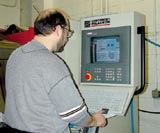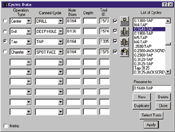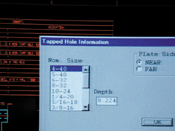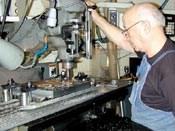CNC Hole Making Without A Programmer
With NC programs created automatically, this shop goes straight from the designer to the machine tool.
Share




Speak of die machining, and most people think of the CNC milling used to arrive at a die's smoothly flowing form. But this is only part of the job. The typical die is an assembly of many machined parts, and some of those parts are simple enough that CNC may just get in the way.
Consider a progressive stamping die, for example. Building dies of this variety is one of the specialties of Brenner Tool, a 400-employee contract manufacturer based in Croydon, Pennsylvania. Each progressive stamping die includes not only a series of milled 3D forms, but also various interlocking plates. These plates feature milled-out 2D pockets and cavities, as well as numerous holes for components like jack screws, fastening screws, dowels and springs. And the need to machine all of these holes is what makes CNC problematic.
Brenner's shop runs a large quantity of these plates—about 40 per day. However, for the most part, this is a large quantity of one-off parts. The typical plate is a unique component designed for one particular die. That's why the shop has historically relied on toolmakers working at milling machines to make these parts, instead of using CNC machining centers. CNC would not have been effective because the one-off work offers no chance to amortize the work of a programmer creating each hole-making move in CAM software. In the time it would take the programmer to think his way through to the right tools and machining strategies for each hole, the toolmaker could perform this same thinking himself...and complete the part as he does so.
But now that obstacle to using CNC effectively has been overcome. Alert to the decline in the number of skilled toolmakers for hire, Brenner Tool has put in place a system that makes machining centers efficient for die plate work.
The key was to skip the programmer.
That's not to say there's no CAM software; there is. However, in Brenner Tool's die plate machining area, CAM software will take on an increasingly less visible role. Here's how:
In the past, what made CNC prohibitively time-consuming was the need for a programmer to apply his machining knowledge during CAM programming. For each hole, the programmer had to select an appropriate series of tools—drill, tap and chamfer, for example—then have the software define the right moves for each of those tools.
But recently, the shop switched to CAM software that permits a different approach. Called PartMaker (from IMCS/PartMaker Software, Fort Washington, Pennsylvania), this "knowledge-based" CAM software automates the programming of hole-making operations by storing and remembering the sequences that define how specific holes are machined. With the right sequences in place in its database, this software can generate an NC program for a complex series of holes automatically, requiring the "programmer" to do no more than identify the holes using a small number of mouse clicks.
However, for Brenner, even this represented too much programming time. This shop took the knowledge-based approach a step further. The company put in place a system to let its die-design CAD software—Cadkey—feed die plate hole information directly to the knowledge-based software. As a result, designs are now translated into NC hole-making programs with minimal human intervention...and without a formal programmer.
That formal programmer is still needed for milling programs. However, the programming task here is much simpler. Right now, the programmer simply edits the hole-making program that was generated automatically to add these milling moves. But in the future, the programmer will instead define this milling work using a separate program entirely, written while hole machining is underway.
The reason to mill with a separate program is that NC programs for hole making will be created right at the machine tool, based on geometry data sent directly to the CNC. To make this streamlined system possible, the PartMaker software has already been loaded onto the PC-based control of one of the machining centers in the die plate area. And soon, two more machining centers will follow suit.
Thus the operators of those machines will be able to run die plate programs as quickly as the software can post them out...and as a result, the shop will machine each one-off plate nearly as efficiently as if it were a large-batch part.
Getting In Position
But Brenner Tool didn't get to this point all at once. Instead, the shop has been streamlining die plate machining for years. Until now, innovations have all centered on letting the toolmaker do his work faster. Perhaps the most significant of these steps forward—and the one that led directly to today's CNC process—came when the shop commissioned a software contractor to have an application written that would pull X-Y hole position coordinates from the die plate CAD files.
That application made it possible for the shop to generate position-only programs for the two-axis controls on its milling machines. With these programs, toolmakers no longer had to spend time looking at prints to calculate X-Y position moves. Instead, the toolmaker could let the machine move from hole position to hole position automatically, while he concentrated on selecting the tools, changing tools, and performing the various machining operations each hole required. In other words, the toolmaker could focus solely on applying his knowledge of hole making.
And all that remained to automate the process fully was to get that knowledge into the process, too.
The shop consulted the same software contractor again for help with this next step. This time, that contractor made a utility for transferring design data directly into the CAM system. And while a third-party utility would not have been essential for this transfer, says CAM supplier IMCS—because the CAD system in question would have permitted other approaches—the third-party utility did make sense for Brenner. The foundation for it had already been laid in the form of the application for generating position programs. By having the contractor simply expand this application, Brenner achieved the software bridge that now connects the shop's CAD and CAM.
Making It Work
The output of the original utility was X and Y coordinates. The knowledge-based CAM software needs these numbers, but it also needs all the information necessary to define each hole. Accordingly, the new utility outputs hole location, diameter, chamfer size, thread pitch for tapped holes, and hole depth when the hole is blind. The CAD model contains some of this information, and for the rest, the die designer adds to the file by clicking through a hole-identification "wizard" built into the third-party application.
This information is what a human user would enter into the knowledge-based CAM software in a typical application where this software stood alone. Included are all the data necessary for the software to match a given hole with the appropriate machining cycle already waiting in the database.
This machining cycle is essentially just a sequence of tools for that hole. The software calculates Z-axis moves itself based on tool geometry, and it calculates speeds and feed rates based on a material library.
Even so, getting the machining cycles into the system took time. The need to input this "knowledge" is the most significant investment the automated programming system required, says Brenner Tool CNC supervisor Yefim Chernyakhovsky. The purchase price of the CAM software was quite low, he says—about one-tenth what the shop paid for the CAM system used previously. However, the true cost was in data-entry time.
To begin, programmers at Brenner established a numbering convention for labeling each tool. Then, dimension data for all of the shop's hole-making tools—drills, reamers, taps, chamfers, etc.—were entered into the software's tool database. This amounted to several thousand tools.
Programmers were then ready to begin establishing cycles for individual holes. This task consists of selecting tools from the tool database. For a 1/4-20 tapped hole, for example, the programmer selects the center drill, drill, chamfer and tap associated with that hole. In this way, programmers at Brenner match holes with tools for every combination of hole type and hole diameter the shop is likely to machine.
This work is still ongoing. In many cases, programmers establish cycles on an as-needed basis. But Mr. Chernyakhovsky puts the work in perspective by comparing it to the way the shop would have programmed before. Even if none of the cycles for a given die plate had yet been entered in the database, he says—but all of the tools had been—then programming the hole-making cycle for that part using the knowledge-based system would still take less time than the previous CAM system would have required.
The Part As Print-Out
In addition, the work of entering each cycle only has to be performed one time. After that, the software remembers how a given hole was machined. This gives the software a distinct advantage over Mr. Chernyakhovsky, for one, who readily admits, "Remembering how you did it last time can be the hardest part of programming a job."
And with the CAD software feeding work to the CNC, the resulting system is more elegant still. In fact, it's elegant enough that a comparison can now be made between machining a design and merely printing it.
True, sending a job to the machine tool is not quite so seamless as sending a drawing to the printer. There is still the operator's role in setup, and there is still the milling programming to be done.
However, printing and machining now do bear this resemblance: At Brenner Tool, at least part of a given design can now travel straight to the machine able to make that design real...and no one has to interpret the work along the way.
Related Content
6 Machine Shop Essentials to Stay Competitive
If you want to streamline production and be competitive in the industry, you will need far more than a standard three-axis CNC mill or two-axis CNC lathe and a few measuring tools.
Read More5 Tips for Running a Profitable Aerospace Shop
Aerospace machining is a demanding and competitive sector of manufacturing, but this shop demonstrates five ways to find aerospace success.
Read More4 Commonly Misapplied CNC Features
Misapplication of these important CNC features will result in wasted time, wasted or duplicated effort and/or wasted material.
Read MoreOrthopedic Event Discusses Manufacturing Strategies
At the seminar, representatives from multiple companies discussed strategies for making orthopedic devices accurately and efficiently.
Read MoreRead Next
Setting Up the Building Blocks for a Digital Factory
Woodward Inc. spent over a year developing an API to connect machines to its digital factory. Caron Engineering’s MiConnect has cut most of this process while also granting the shop greater access to machine information.
Read MoreBuilding Out a Foundation for Student Machinists
Autodesk and Haas have teamed up to produce an introductory course for students that covers the basics of CAD, CAM and CNC while providing them with a portfolio part.
Read MoreRegistration Now Open for the Precision Machining Technology Show (PMTS) 2025
The precision machining industry’s premier event returns to Cleveland, OH, April 1-3.
Read More





































